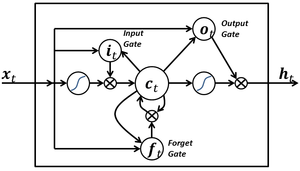Long short-term memory

Long short-term memory (LSTM) is a recurrent neural network (RNN) architecture (an artificial neural network) proposed in 1997 by Sepp Hochreiter and Jürgen Schmidhuber.[2] Like most RNNs, an LSTM network is universal in the sense that given enough network units it can compute anything a conventional computer can compute, provided it has the proper weight matrix, which may be viewed as its program. Unlike traditional RNNs, an LSTM network is well-suited to learn from experience to classify, process and predict time series when there are very long time lags of unknown size between important events. This is one of the main reasons why LSTM outperforms alternative RNNs and hidden Markov models and other sequence learning methods in numerous applications. For example, LSTM achieved the best known results in unsegmented connected handwriting recognition,[3] and in 2009 won the ICDAR handwriting competition. LSTM networks have also been used for automatic speech recognition, and were a major component of a network that in 2013 achieved a record 17.7% phoneme error rate on the classic TIMIT natural speech dataset.[4] As of 2016, major technology companies including Google, Apple, Microsoft, and Baidu are using LSTM networks as fundamental components in new products.[5][6]
Architecture

A LSTM network is an artificial neural network that contains LSTM blocks instead of, or in addition to, regular network units. A LSTM block may be described as a "smart" network unit that can remember a value for an arbitrary length of time. A LSTM block contains gates that determine when the input is significant enough to remember, when it should continue to remember or forget the value, and when it should output the value.
A typical implementation of a LSTM block is shown to the right. The four units shown at the bottom of the figure are sigmoid units , where s is some squashing function, such as the logistic function. The left-most of these units computes a value which is conditionally fed as an input value to the block's memory. The other three units serve as gates to determine when values are allowed to flow into or out of the block's memory. The second unit from the left (on the bottom row) is the "input gate". When it outputs a value close to zero, it zeros out the value from the left-most unit, effectively blocking that value from entering into the next layer. The third unit from the left is the "forget gate". When it outputs a value close to zero, the block will effectively forget whatever value it was remembering. The right-most unit (on the bottom row) is the "output gate". It determines when the unit should output the value in its memory. The units containing the symbol compute the product of their inputs (). These units have no weights. The unit with the symbol computes a linear function of its inputs (). The output of this unit is not squashed so that it can remember the same value for many time-steps without the value decaying. This value is fed back in so that the block can "remember" it (as long as the forget gate allows). Typically, this value is also fed into the 3 gating units to help them make gating decisions.
Traditional LSTM
Traditional LSTM with forget gates.[2][7] and . denotes the Hadamard product.
Variables
- : input vector
- : output vector
- : cell state vector
- , and : parameter matrices and vector
- , and : gate vectors
- : Forget gate vector. Weight of remembering old information.
- : Input gate vector. Weight of acquiring new information.
- : Output gate vector. Output candidate.
- : The original is a sigmoid function.
- : The original is a hyperbolic tangent.
- : The original is a hyperbolic tangent, but the peephole LSTM paper suggests .[8][9]
Peephole LSTM
Peephole LSTM with forget gates.[8][9] is not used, is used instead in most places.
Convolutional LSTM
Convolutional LSTM.[10] denotes the convolution operator.
Training
To minimize LSTM's total error on a set of training sequences, iterative gradient descent such as backpropagation through time can be used to change each weight in proportion to its derivative with respect to the error. A major problem with gradient descent for standard RNNs is that error gradients vanish exponentially quickly with the size of the time lag between important events, as first realized in 1991.[11][12] With LSTM blocks, however, when error values are back-propagated from the output, the error becomes trapped in the memory portion of the block. This is referred to as an "error carousel", which continuously feeds error back to each of the gates until they become trained to cut off the value. Thus, regular backpropagation is effective at training an LSTM block to remember values for very long durations.
LSTM can also be trained by a combination of artificial evolution for weights to the hidden units, and pseudo-inverse or support vector machines for weights to the output units.[13] In reinforcement learning applications LSTM can be trained by policy gradient methods, evolution strategies or genetic algorithms.
Applications
Applications of LSTM include:
- Robot control[14]
- Time series prediction[15]
- Speech recognition[16][17][18]
- Rhythm learning[9]
- Music composition[19]
- Grammar learning[20][8][21]
- Handwriting recognition[22][23]
- Human action recognition[24]
- Protein Homology Detection[25]
See also
- Differentiable neural computer
- Artificial neural network
- Prefrontal Cortex Basal Ganglia Working Memory (PBWM)
- Recurrent neural network
- Time series
- Long-term potentiation
References
- ↑ Klaus Greff; Rupesh Kumar Srivastava; Jan Koutník; Bas R. Steunebrink; Jürgen Schmidhuber (2015). "LSTM: A Search Space Odyssey". arXiv:1503.04069
 .
. - 1 2 Sepp Hochreiter; Jürgen Schmidhuber (1997). "Long short-term memory" (PDF). Neural Computation. 9 (8): 1735–1780. doi:10.1162/neco.1997.9.8.1735. PMID 9377276.
- ↑ A. Graves, M. Liwicki, S. Fernandez, R. Bertolami, H. Bunke, J. Schmidhuber. A Novel Connectionist System for Improved Unconstrained Handwriting Recognition. IEEE Transactions on Pattern Analysis and Machine Intelligence, vol. 31, no. 5, 2009.
- ↑ Graves, Alex; Mohamed, Abdel-rahman; Hinton, Geoffrey (2013). "Speech Recognition with Deep Recurrent Neural Networks". Acoustics, Speech and Signal Processing (ICASSP), 2013 IEEE International Conference on: 6645–6649.
- ↑ "With QuickType, Apple wants to do more than guess your next text. It wants to give you an AI.". WIRED. Retrieved 2016-06-16.
- ↑ "RECURRENT NEURAL NETWORKS - FEEDBACK NETWORKS - LSTM RECURRENT NETWORK - FEEDBACK NEURAL NETWORK - RECURRENT NETS - FEEDBACK NETWORK - RECURRENT NET - - FEEDBACK NET". people.idsia.ch. Retrieved 2016-06-16.
- ↑ Felix A. Gers; Jürgen Schmidhuber; Fred Cummins (2000). "Learning to Forget: Continual Prediction with LSTM". Neural Computation. 12 (10): 2451–2471. doi:10.1162/089976600300015015.
- 1 2 3 Gers, F. A.; Schmidhuber, J. (2001). "LSTM Recurrent Networks Learn Simple Context Free and Context Sensitive Languages". IEEE Transactions on Neural Networks. 12 (6): 1333–1340. doi:10.1109/72.963769.
- 1 2 3 Gers, F.; Schraudolph, N.; Schmidhuber, J. (2002). "Learning precise timing with LSTM recurrent networks". Journal of Machine Learning Research. 3: 115–143.
- ↑ Xingjian Shi; Zhourong Chen; Hao Wang; Dit-Yan Yeung; Wai-kin Wong; Wang-chun Woo (2015). "Convolutional LSTM Network: A Machine Learning Approach for Precipitation Nowcasting". Proceedings of the 28th International Conference on Neural Information Processing Systems: 802–810.
- ↑ S. Hochreiter. Untersuchungen zu dynamischen neuronalen Netzen. Diploma thesis, Institut f. Informatik, Technische Univ. Munich, 1991.
- ↑ S. Hochreiter, Y. Bengio, P. Frasconi, and J. Schmidhuber. Gradient flow in recurrent nets: the difficulty of learning long-term dependencies. In S. C. Kremer and J. F. Kolen, editors, A Field Guide to Dynamical Recurrent Neural Networks. IEEE Press, 2001.
- ↑ Schmidhuber, J.; Wierstra, D.; Gagliolo, M.; Gomez, F. (2007). "Training Recurrent Networks by Evolino". Neural Computation. 19 (3): 757–779. doi:10.1162/neco.2007.19.3.757.
- ↑ H. Mayer, F. Gomez, D. Wierstra, I. Nagy, A. Knoll, and J. Schmidhuber. A System for Robotic Heart Surgery that Learns to Tie Knots Using Recurrent Neural Networks. Advanced Robotics, 22/13–14, pp. 1521–1537, 2008.
- ↑ J. Schmidhuber and D. Wierstra and F. J. Gomez. Evolino: Hybrid Neuroevolution / Optimal Linear Search for Sequence Learning. Proceedings of the 19th International Joint Conference on Artificial Intelligence (IJCAI), Edinburgh, pp. 853–858, 2005.
- ↑ Graves, A.; Schmidhuber, J. (2005). "Framewise phoneme classification with bidirectional LSTM and other neural network architectures". Neural Networks. 18 (5–6): 602–610. doi:10.1016/j.neunet.2005.06.042.
- ↑ S. Fernandez, A. Graves, J. Schmidhuber. An application of recurrent neural networks to discriminative keyword spotting. Intl. Conf. on Artificial Neural Networks ICANN'07, 2007.
- ↑ Graves, Alex; Mohamed, Abdel-rahman; Hinton, Geoffrey (2013). "Speech Recognition with Deep Recurrent Neural Networks". Acoustics, Speech and Signal Processing (ICASSP), 2013 IEEE International Conference on: 6645–6649.
- ↑ D. Eck and J. Schmidhuber. Learning The Long-Term Structure of the Blues. In J. Dorronsoro, ed., Proceedings of Int. Conf. on Artificial Neural Networks ICANN'02, Madrid, pages 284–289, Springer, Berlin, 2002.
- ↑ Schmidhuber, J.; Gers, F.; Eck, D.; Schmidhuber, J.; Gers, F. (2002). "Learning nonregular languages: A comparison of simple recurrent networks and LSTM". Neural Computation. 14 (9): 2039–2041. doi:10.1162/089976602320263980.
- ↑ Perez-Ortiz, J. A.; Gers, F. A.; Eck, D.; Schmidhuber, J. (2003). "Kalman filters improve LSTM network performance in problems unsolvable by traditional recurrent nets". Neural Networks. 16 (2): 241–250. doi:10.1016/s0893-6080(02)00219-8.
- ↑ A. Graves, J. Schmidhuber. Offline Handwriting Recognition with Multidimensional Recurrent Neural Networks. Advances in Neural Information Processing Systems 22, NIPS'22, pp 545–552, Vancouver, MIT Press, 2009.
- ↑ A. Graves, S. Fernandez,M. Liwicki, H. Bunke, J. Schmidhuber. Unconstrained online handwriting recognition with recurrent neural networks. Advances in Neural Information Processing Systems 21, NIPS'21, pp 577–584, 2008, MIT Press, Cambridge, MA, 2008.
- ↑ M. Baccouche, F. Mamalet, C Wolf, C. Garcia, A. Baskurt. Sequential Deep Learning for Human Action Recognition. 2nd International Workshop on Human Behavior Understanding (HBU), A.A. Salah, B. Lepri ed. Amsterdam, Netherlands. pp. 29–39. Lecture Notes in Computer Science 7065. Springer. 2011
- ↑ Hochreiter, S.; Heusel, M.; Obermayer, K. (2007). "Fast model-based protein homology detection without alignment". Bioinformatics. 23 (14): 1728–1736. doi:10.1093/bioinformatics/btm247. PMID 17488755.
External links
- Recurrent Neural Networks with over 30 LSTM papers by Jürgen Schmidhuber's group at IDSIA
- Gers PhD thesis on LSTM networks.
- Fraud detection paper with two chapters devoted to explaining recurrent neural networks, especially LSTM.
- Paper on a high-performing extension of LSTM that has been simplified to a single node type and can train arbitrary architectures.
- Tutorial: How to implement LSTM in python with theano